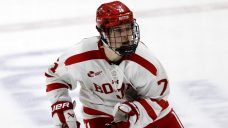I’m as guilty as any Ottawa Senators fan. I honestly thought this was going to be the season when the Sens snuck into a wild-card slot and qualified for the playoffs.
But instead of writing about what the Sens could be adding ahead of the trade deadline to assist with their playoff push, I’m back to square one trying to assess what went wrong — again — this year in Ottawa.
To be honest, I’m frustrated this team hasn’t evolved.
They appear stuck in neutral. They tease me with solid play on occasion, recently going on a 7-2-1 run over a 10-game segment, but they can’t seem to sustain momentum for extended periods of time. They now own a four-game losing streak after dropping Saturday's game to Philadelphia.
At this stage, I’m struggling with their team identity.
What does it mean to be an Ottawa Senator? How do they play as a team? What’s the team culture?
Their captain, Brady Tkachuk, plays with all kinds of truculence and skill. But who else on the roster backs him up with a secondary layer of the same?
The group on defence is heavily weighted on the left side. Thomas Chabot and Jake Sanderson are signed to long-term extensions, with both contracts averaging about $8 million dollars per season.
Is there room to eventually extend Jakob Chychrun at the same amount of money, or possibly more? Does it make sense to have that kind of money tied up in three left-handed slots on the back end?
The goal of this exercise is to analyze the positive, negative, and areas of opportunity for the Ottawa Senators leading into trade deadline and beyond.
Here’s my breakdown:
THE FORWARDS
Ottawa has a forward group that can push the pace. Their speed in transition gives opposing defences all they can handle some nights.
A statistic that stands out for me, though, is the fact the Senators only have one player among the NHL's top 40 scoring leaders.
• Tim Stützle is ranked 40th in league scoring. Claude Giroux slots in as the the 50th leading scorer in the NHL.
• A positive takeaway from the list of Ottawa's top six scoring forwards is their age. Only Giroux and Vladimir Tarasenko are older than 30. Tarasenko is likely to be traded this week.
• A name that doesn’t appear within Ottawa's top six scoring forwards, but will certainly be one of their core scorers in the future, is Shane Pinto. Since Pinto returned from serving his lengthy suspension for breaching the NHL’s gambling rules, he has dressed for 18 games and contributed six goals and 10 assists.
• Josh Norris can’t seem to buy a break when it comes to staying healthy. The oft-injured forward has been sidelined again with what appears to be another shoulder injury. When Norris is at the top of his game, he’s a play driver between the blue lines. He provides better than secondary scoring, averages around 18 minutes of ice time deployed in all situations, wins over 52 per cent of his draws and has some physical push-back at times. Norris has been credited with 115 shots on goal, 84 hits and 30 shot blocks. He plays a significant role for the Senators when he’s in the lineup.
• Drake Batherson averages around 17:30 of ice time per game, all of which comes at even strength and the power play. One of Batherson’s top qualities is his ability to position himself around the crease for tips and rebounds. He leverages well in the trenches.
Batherson sets up shop either net front, or in the bumper position on the power play. He looks capable of scoring 30-plus goals in time.

• Tkachuk is an intense competitor who leads by example. There’s absolutely no doubt about how much he cares and wants to win. There are nights when he’s a bit distracted in scrums during and after the whistle, but he gives opponents all they can handle physically.
Tkachuk averages nearly 19 minutes of ice time and is deployed at even strength and the power play. He’s like a bull in a china shop. He isn’t the most skilled, or fluid-looking power forward in the NHL, but he gets results.
Tkachuk has directed 248 shots on goal and dished out 198 hits. Both stats are ranked sixth-best in the NHL.
• Similar to most NHL teams, especially in the cap era, the Senators' top six forwards produce the bulk of the team's offence by a very wide margin. The top six has produced 275 points, compared to 92 points from the rest of their forwards.
• If Mathieu Joseph is capable of providing the secondary scoring he has this year (10 goals, 20 assists) and continues to play a generally responsible, competitive, three-zone game he'll bring decent value at $2.95 million (his contract expires in 2026). But he needs to maintain momentum.
• I expect Ridly Greig to take another step offensively. Greig has averaged around 15 minutes of ice time and is already proving capable to be used in all situations. Greig leads the Senators with a plus-17 rating.
• The Senators are well positioned with this group, even with the pending departure of Tarasenko, but Norris's injury history has the potential to leave a void in the lineup that the Senators might be forced to address this off-season.
DEFENCEMEN
Ottawa’s defence has been assembled in a curious manner. They are stacked on the left side, with Chabot, Sanderson, and Chychrun. The first two are signed for the long haul.
• Artem Zub is arguably the Senators' most complete defenceman. Despite the fact he doesn’t have a regular role on either one of Ottawa’s power-play units, Zub has contributed secondary scoring. Zub and Jake Sanderson lead the Sens defence in even-strength scoring with 20 points apiece.
• Zub matches up against top opponents every night. He’s also one of the Senators' primary penalty killers. His plus-10 rating leads the group.
• Both Erik Brannstrom and Jacob Bernard-Docker have taken a step forward this year in Ottawa. On a non-playoff team, they have provided reliable results. Both players are plus-2, average around 16 minutes of ice time, and have a role on the penalty kill. Bernard-Docker, along with Chychrun, lead the Senators defence with 107 shot blocks.
About the left side...
• It’s hard for me to imagine it makes sense for Ottawa to distribute so much of their future cap space in the combination of Chabot, Sanderson and Chychrun.
• Ottawa doesn’t have to make a move by the trade deadline, but NHL teams will be interested if one of these three defenceman is available.
• There are pros and cons to moving one of these players, and adding elsewhere in their lineup in the process:
Chychrun has one more year left on his contract ($4.6M AAV) before becoming a UFA. He will be due a raise. Chychrun leads the Senators defence with 31 points. He’s their most productive blueliner on the power play (4G-8A). The fact he doesn’t penalty kill and has the worst plus/minus (minus-15) has to be considered as well.
Chabot has suffered through some injury setbacks this season and has only played 37 games, producing six goals and 16 assists. Chabot logs the most ice time of any Senators defenceman (23:59). He’s deployed in all situations, but he’s used as a secondary penalty-killer. Chabot is minus-3 on the year.
Sanderson is the youngest of the three at only 21. His extension kicks in next season ($8.05 million through 2031-32). It’s my opinion Sanderson projects to be the most reliable, long-term player of the three. He’s already averaging 23 minutes of ice time, skating all situations, has posted seven goals and 20 assists and is a plus-7.
Organizational depth on D...
• The Senators have some solid defence prospects in their system. Tyler Kleven has been solid in the AHL (Belleville), as has Maxence Guenette.
Other defenders developing in junior or college include Jorian Donovan (Saginaw OHL), Hoyt Stanley (Cornell ECAC), and Tomas Hamara (Brantford OHL).
GOALTENDERS
I can’t sugarcoat this one!
• The Senators have the worst team save percentage in the entire NHL at .880.
• Joonas Korpisalo is signed through the 2027-28 season at $4 million against the cap.
• Anton Forsberg will be entering the last year of his contract next season. He’s being paid $2.75 million.
• Mads Søgaard is a pending RFA. His qualifying offer this summer is set at $874,125.
Someone needs to step up and win the crease next season for Ottawa. If not from within, they would be wise to shop for an upgrade this off-season, through trade or free agency. There’s zero chance this group becomes a playoff team with a sub-.900 save percentage as a team.
THE COACHING QUESTION
Perhaps the most important transaction the Senators will make this off-season is the hiring of their next head coach.
It’s my belief this team needs a coach who has a proven track record. A coach who has won in regular season and playoffs. Someone who will have the attention of the group at all times and hold them accountable.
I would be reaching out to Craig Berube and Gerard Gallant for interviews. Both are veteran coaches who fit the criteria I’m looking for. They are both proven winners who demand accountability from their teams.
DRAFT CAPITAL
The Sens' draft board is pretty flush for the next three cycles.
Their own 2024 first-round pick projects to be a top eight selection. The pick they own from Boston has several conditions, but it’s safe to assume the pick will end up landing between 24-32.
Ottawa has done a nice job of stockpiling their system with prospects through the draft.
The extra picks they have accumulated now provides the organization with some flexibility. Ottawa could elect to use those picks, or trade out some draft capital to acquire immediate NHL roster assistance for next season and beyond.

TRADE PROPOSAL
I don’t see how the left side of their defence group can remain intact beyond next season. With that in mind, I recommend the following trade, which could be done this deadline:
To Florida: Jakob Chychrun
To Ottawa: Anton Lundell, 2025 second-round pick
Chychrun would provide more scoring depth for the Panthers and complement either Brandon Montour or Aaron Ekblad. Montour is a pending UFA. Chychrun has one more year left on his contract, so Florida could perhaps decide to extend Chychrun instead of Montour in this process.
Lundell is only 22 and was drafted in the first round (12th overall) of the 2020 NHL draft. He would add an element the Senators lack in the middle of their forward group. Lundell, at worst, provides secondary scoring and plays a detailed three-zone game overall. He’s plus-14, wins 53 per cent of his draws and can match up against top six opponents. This would be the first of many changes I would make to this roster before the start of next season.
When this season ends and the off-season player availability starts to take shape (trades, free agents, etc.) I'll explore this team again and explore what those other changes could be.






